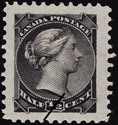History of Postal Services in the Saskatoon Area

In 1875 the countryside around the future site of Saskatoon was open prairie with no permanent occupants. The Cree were moving with the bison herds through the region. This was truly a 'Great Lone Land'.
Saskatoon is in the parkland belt, which was composed maily of grassland interspersed with bluffs of poplar unsuitable for the construction of permanent housing.

In September 1881 the Temperance Colonization Society was formed in Toronto by a group of men intent on establishing a settlement in Saskatchewan which excluded the availability of intoxicating liquors.
John Lake, Commissioner of the Temperance Society, along with others surveyed the area in the summer of 1882. The name 'Saskatoon', the Cree name for the fruit borne by local bushes shown to Lake by a member of the survey crew, was chosen for the new settlement on the east bank of the South Saskatchewan River.
The first settlers began to arrive in 1883. They had travelled by rail through the United States to Winnipeg and then via the CPR to Moose Jaw. From there they went by ox cart or horse-drawn wagon to Saskatoon, a journey of a month to the day. This too was the route mail initially took to Saskatoon, but service was erratic, and virtually non-existent during the winter. Eventually trips to and fro Moose Jaw could be made in about a week, likely the shorter time reflecting smaller loads such as the mail.
![]() The following year the Temperance Society was successful in its bid for a post office which has established 01 October 1884 on the corner of Broadway Avenue and Main Street in the district which is now called Nutana serving about 35 settlers. The first postmaster was Dr. J H C Willoughby.
The following year the Temperance Society was successful in its bid for a post office which has established 01 October 1884 on the corner of Broadway Avenue and Main Street in the district which is now called Nutana serving about 35 settlers. The first postmaster was Dr. J H C Willoughby.
In those days mail reached Batoche from Winnipeg along the Saskatchewan Trail, later called the Carlton Trail. Following the establishment of the first post office, mail service to Saskatoon was provided once a fortnight through Batoche, 88 km to the north on the South Saskatchewan River. As early as 1882 there was an established trail from Moose Woods (located 26 km south of Saskatoon and currently known as the Dakota Whitecape Reserve) to Batoche, passing through what was later to become the settlement of Saskatoon. Frank Clark had the contract to carry the mail along this route.. Clark would stay at the home of Archibald L. Brown in Saskatoon in order to get an early start on his mail run the next morning. The trip from Saskatoon to Fish Creek was difficult due to lack of shelter, but from Fish Creek to Batoche the trail passed through Métis country and turned in at every door.
The arrival of the railway in 1890 and the placement of the station on the west side of the river shifted development away from the original community on the opposite bank.
![]() By 1900 residents were petitioning for a post office to replace that on the east side of the river. On 1 August 1900 a post office called West Saskatoon was established, with Allan Bowerman as first postmaster. The east side office kept the name Saskatoon until 1 Jan 1902 when it was renamed 'Nutana'.
By 1900 residents were petitioning for a post office to replace that on the east side of the river. On 1 August 1900 a post office called West Saskatoon was established, with Allan Bowerman as first postmaster. The east side office kept the name Saskatoon until 1 Jan 1902 when it was renamed 'Nutana'.
By 1919 the Nutana post office had become Saskatoon sub post office #1.
